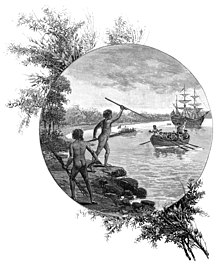Kurnell Peninsula Headland
The Kurnell Peninsula Headland , (German: Cape of the Kurnell Peninsula ) on Botany Bay , is the area where James Cook first set foot on Australian soil on April 29, 1770 . The southeastern area at the tip of the peninsula with significant historical traces was declared a national monument by the Australian government in 2004 .
history
Cook sailed his ship, the Endeavor , along the east coast of Australia in search of a safe landing spot after coming from Tasmania . He found a suitable place on the northeast coast of the Kurnell Peninsula and stayed there for eight days, measuring the coast and taking in food and water. The British saw the indigenous population, but Cook tried unsuccessfully to contact the Gweagal Aborigines living there.
"I thought that they beckoned to come ashore, but in this we were mistaken, for as soon as we put the boat in they again come to oppose us ... I fired a musket between the two which had no effect ... one of them took a stone and threw it at us ... "(Cook's journal, April 29, 1770)
The naturalist Joseph Banks and the Swedish botanist Daniel Solander explored the Kurnell Peninsula and Botany Bay in the eight days they spent there . They provided the first scientific results about the Australian flora and fauna. A tree genus that Banks discovered back then, the Banksia , is named after him in his honor.
Cook's detailed description of Botany Bay and the peninsula, the presence of water, resulted in British sailors on the First Fleet having accurate information.
Entering Australia for the first time and Cook's journey is not only anchored in the memory of European history, it is also common among the Aborigines in remote areas of Australia, in Victoria , Central Australia and the Northern Territory .
Monument protection
Due to the historical importance of this area, the southeastern part of the Kurnell Peninsula was placed under national monument protection by the Australian government on September 20, 2004 and entered on the Australian National Heritage List . The area covers about 400 hectares within the Botany Bay National Park .
Monuments
There are several monuments in the protected area of the Kurnell Peninsula that can be reached on hiking trails, they are:
- Captain Cook Memorial Obelisk
- Sir Joseph Banks Memorial
- Daniel Solander Monument
- Joseph Banks Monument
There is also a grave mark on the Kurnell Peninsula of the British sailor Forby Sutherland, who was the first British man to die in Australia. He died of tuberculosis on May 2, 1770 while there.
photos
Obelisk for James Cook
Monument to Joseph Banks
Monument to Daniel Solander
Web links
- environment.gov.au (PDF; 278 kB): Site plan of the protected area, the Kurnell Peninsula Headland
Individual evidence
- ↑ environment.gov.au ( Memento of the original from November 23, 2011 in the Internet Archive ) Info: The archive link was automatically inserted and not yet checked. Please check the original and archive link according to the instructions and then remove this notice. (PDF; 626 kB): Kurnell Penisula. Cook's Landing Place , accessed October 18, 2011
- ↑ a b environment.gov.au ( Memento of the original from June 6, 2011 in the Internet Archive ) Info: The archive link was inserted automatically and has not yet been checked. Please check the original and archive link according to the instructions and then remove this notice. (PDF; 29 kB): Department of the Environment and Heritage : Kurnell Peninsula Headland , in English, accessed on October 18, 2011
Coordinates: 34 ° 0 ′ 16.8 ″ S , 151 ° 13 ′ 3.2 ″ E






